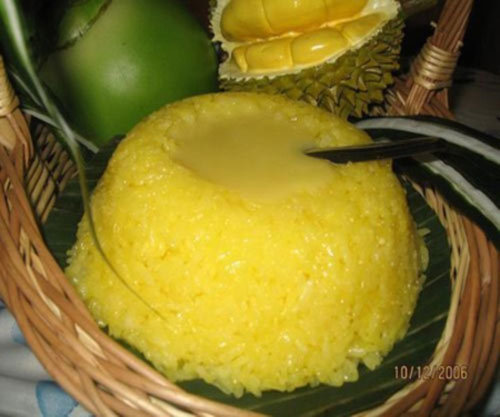Sticky rice is also a specialty you should not miss when coming to this land. To have a delicious basket of sticky rice, it is necessary to choose Thai sticky rice bought at Ha Tien market, transported along the Cambodian border. Thai sticky rice is chosen to buy because it is more flexible and delicious than Vietnamese sticky rice. Before cooking sticky rice, soak the sticky rice for about 4-5 hours, then drain the water with lychee and steam for half an hour. The filling of sticky rice consists of our chicken eggs, beaten until it floats, then got Siamese coconut juice, marinated with Thot Not sugar and Thai granulated sugar. It is necessary to steam separately in another pot. Usually pandan leaves, a type of fragrant leaf, are put in a pot of cooking water. It is thanks to this ingredient that sticky rice, in addition to its sweet and greasy taste, also has a very strange aroma. When eating Siamese sticky rice, people put the sticky rice on a plate, drizzle sauce and coconut milk on top.
Source: Collected internet.
Vietnam is an exciting country for tourism and investment. Bustling street life, delicious cuisine and majestic scenery all await you. A country constantly in motion, Vietnam always balances young urban culture with traditional values. In the city, ancient temples are just a turn away from modern shops. In the countryside, life still flows along the rivers and harvests. This contrast between old and new makes up a large part of Vietnam's appeal. Another reason to visit Vietnam is its natural beauty. The North has majestic mountains and beautiful limestone bays. The Central Coast Road leads to historical relics and romantic beaches. And in the South, the sleepless life of Ho Chi Minh City and the riverside villages in the Mekong Delta will make you want to linger forever.
The streets paint the lives of Vietnamese people. The streets here are not just for traveling. Streets and sidewalks are also places to shop, eat, meet for a cup of coffee, get a haircut or rest. Big cities are always full of life with the roar of millions of motorbikes, where you can feel a constant source of energy bubbling on every street.
Vietnam is located in the Indomalaya ecological region. According to the 2005 National Environmental Status Report, Vietnam is among the 25 countries with high levels of biodiversity, ranked 16th worldwide in terms of biodiversity and is home to about 16% of the world's biodiversity. species in the world. 15,986 plant species have been found throughout the country, of which 10% are endemic. Vietnam has 307 species of nematodes, 200 species of oligochaeta, 145 species of acarina, 113 species of springtails, 7,750 species of insects, 260 species of reptiles. , 120 species of amphibians, 840 species of birds and 310 species of mammals, of which 100 species of birds and 78 species of mammals are endemic. There are also 1,438 species of freshwater algae, accounting for 9.6% of the total number of algae species, as well as 794 species of aquatic invertebrates and 2,458 species of marine fish. In the late 1980s, a population of Javan Rhinos was discovered in Cat Tien National Park and it is possible that the last individual of this species in Vietnam died in 2010.
Vietnam is a country with 54 different ethnic groups, each of which has its own unique and impressive culture and identity. It is this difference in ethnic composition that has contributed to creating a very diverse, rich and unique beauty for Vietnam's culture that no other country can replace. Customs in Vietnam have a long tradition spanning thousands of years, it has become customary law, deep and firmly embedded in the hearts of every Vietnamese person.
